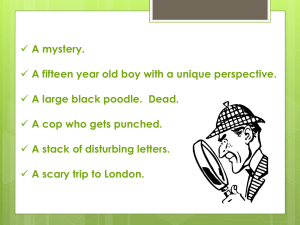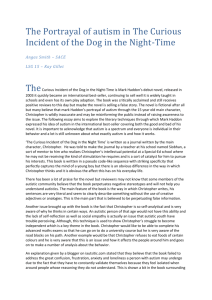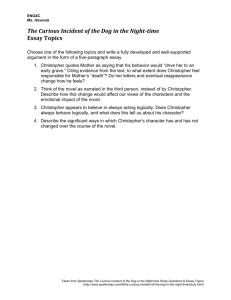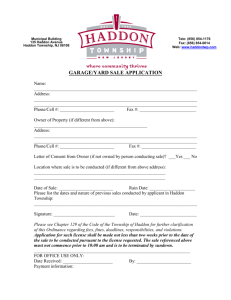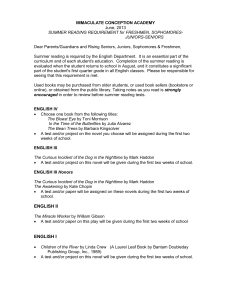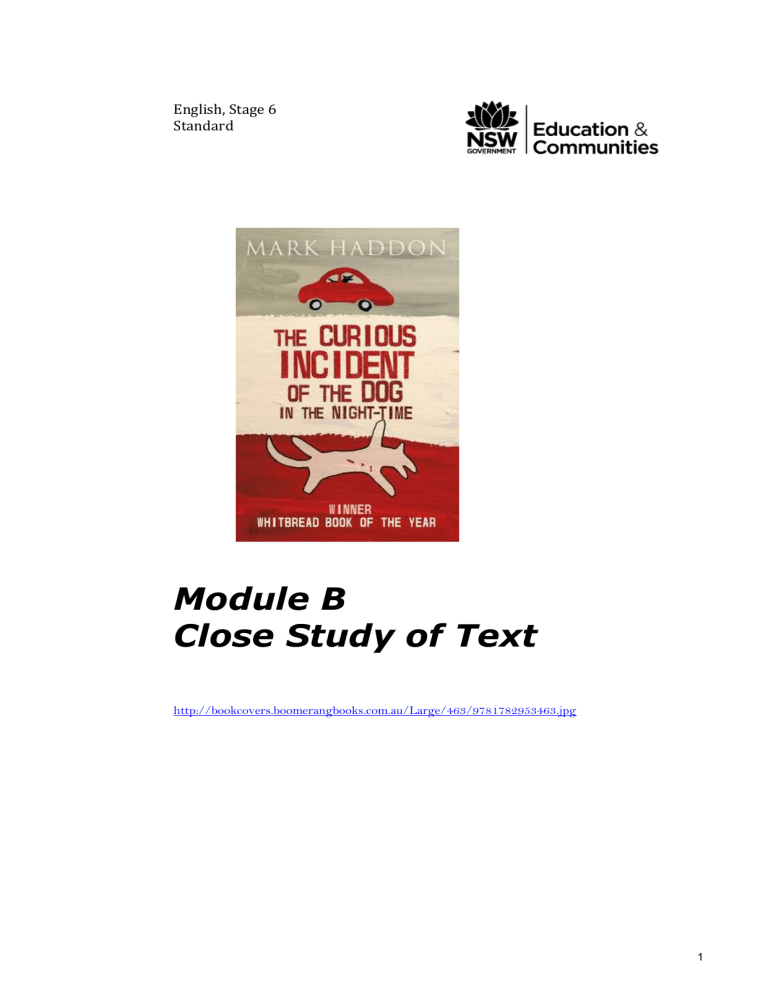
English, Stage 6 Standard Module B Close Study of Text http://bookcovers.boomerangbooks.com.au/Large/463/9781782953463.jpg 1 Acknowledgements Southern Cross Distance Education Centre gratefully acknowledges the following owners of copyright material. Centre for Learning Innovation always keep CLI acknowledgement © DET materials adapted from The Curious Incident of the Do in the Night-time by Mark Haddon and written by Shelley McNamara from Southern Cross Distance Education. Edited by John Ryan from Southern Cross Distance Education. March 2015 NOTICE ON MATERIAL REPRODUCED OR COMMUNICATED UNDER STATUTORY TEXT AND ARTISTIC LICENCE FORM OF NOTICE FOR PARAGRAPH 135ZXA(a) OF COPYRIGHT ACT 1968 COMMONWEALTH OF AUSTRALIA Copyright Regulations 1969 WARNING This material has been reproduced and communicated to you by or on behalf of Southern Cross Distance Education Centre pursuant to Part VB of the Copyright Act 1960 (the Act). This material in this communication may be subject to copyright under the Act. Any further reproduction or communication of this material by you may be subject of copyright protection under the Act. Do not remove this notice. Enclosures To complete this unit, you will need: The Curious Incident of the Dog in the Night-Time by Mark Haddon USB: trailer 2 Unit overview In Module B students are required to undertake a close study of one prescribed text. Your text is The Curious Incident of the Dog in the Night-Time by Mark Haddon. As you engage in a detailed analysis of the text you will develop an understanding of how ideas, forms and language of a text interact within the text and affect the responder. The unit begins by introducing the rubric (language) of the syllabus and connects these to The Curious Incident of the Dog in the Night-Time. To do this, consider Haddon’s personal context and the distinctive qualities of the text including narrative elements such as structure, form, genre, characters, setting and language. Student will also consider key ideas and concepts and analyse key scenes in the novel. The last part of the unit focuses on Paper 2, Section 2 of the HSC English exam where you will need to write a Close Study of Text essay. You have the opportunity to learn about: closely studying a text Haddon’s personal context and how this has influenced his work textual elements key ideas and concepts key scenes how to prepare for HSC English Paper 1 examination. You have the opportunity to learn to: • prepare for the HSC English examination Paper 2, Section 2 • analyse distinctive qualities of The Curious Incident of the Dog in the Night-Time • practise answering HSC examination style questions. You should only return one part of the booklet back for marking at a time. Rationale for approach used in this teaching program This module requires you to have a close, detailed knowledge and understanding of the novel and Mark Haddon’s craft. The unit of work focuses on engaging you personally and deeply with the prescribed text The Curious Incident of the Dog in the Night-Time through a range of activities on all aspects of the novel such as: setting, characterisation, themes, key incidents, the main ideas, the structure and the language of the novel. Outcomes Students are working towards achieving the following outcomes: 6. A student engages with the details of text in order to respond closely and personally. 7. A student selects appropriate language forms and features, and structures of texts to explore and express ideas and values. 11. A student draws upon the imagination to transform experience and ideas into text, demonstrating control of language. 13. A student reflects on own processes of learning. 3 Suggested time The Close Study of Text is worth 20% of the HSC course and should be given approximately the same proportion of time to complete. Time management then is central to your success. Your teacher may suggest different ways to manage your time as you move through the unit. Always carefully consider the instructions given by your teacher. 4 Part 1: Introduction to Module B http://sweatpantsandcoffee.com/what-we-love/classics-worth-reading Key words Craft: creative skill or ability Distinctive qualities: qualities of the text that make it unique, memorable and different Perceptions: Perception refers to the interplay of recognition and interpretation and is influenced by our preconceived ideas, memories, experiences and senses Textual integrity: the unity of a text or how all the textual elements that make up the text work together to achieve a meaningful purpose Autism Syndrome Disorder (ASD): is characterised by significant difficulties in social interaction and nonverbal communication, alongside restricted and repetitive patterns of behavior and interests Modality: Language that communicates degrees of meaning or strength or weakness, for example ‘maybe’ (low modality) as opposed to definitely (high modality) 5 Understanding Module B In Module B you are required to closely study one prescribed text. Your text is The Curious Incident of the Dog in the Night-Time by Mark Haddon. Key ideas Key ideas tell you how you are to approach a close study of The Curious Incident of the Dog in the Night-Time. You are required to: engage with the text to respond imaginatively, affectively and critically explore and analyse particular characteristics of the text, considering how these shape meaning consider the ways in which these characteristics of the text establish the text’s distinctive qualities create compositions focusing on how meaning is shaped in and through the text in a variety of forms and media analyse the text’s construction, context and language explore how the features of the text contribute to textual integrity. Analysis of rubric for key ideas The rubric is what the syllabus says you are required to do. As Module B requires you to study closely the novel The Curious Incident of the Dog in The Night Time, you need to ensure that you have a thorough understanding of all aspects of the novel. According to the rubric, the following key ideas ensure Deep Learning: Construction: How meaning is shaped and conveyed through the interaction in the novel of: Ideas: These are the key ideas and concepts represented in and through the novel that form a personal and intellectual connection with the novel. Form: The genre and structure of the novel. Language: The meaning is conveyed through language features such as figurative language, dialogue, etc. Positioning: The novel’s textual details and features will affect the reader in some way and position the reader to respond. Textual Integrity: How the unified characteristics of a text establish its distinctive features. Writing your best response Below is an outline of what makes an effective response in the HSC Examination: deep understanding of an idea or related ideas is shown by drawing on detailed textual knowledge a personal perspective is demonstrated. the purpose of their texts is demonstrated through a conceptual understanding of the novel. Develop ideas by referring to the whole novel, not just the beginning of the novel. appropriate textual evidence and explanation about why this textual evidence is valid is clearly demonstrated metalanguage is used that is appropriate to their text type. 6 Key questions ‘A novel can put you inside another person's head and give you an understanding of their life you could only get by moving into their house for six months.’ Mark Haddon. You will notice these key questions have been sorted into 3 categories: craft, distinctive qualities and perceptions. When you study the novel consider the following questions about these 3 categories. Craft - Textuality: Craft refers to the skill or artistry and how well the elements of the text work together (textual integrity) a) How do the text’s textual features and details, structure and form shape meaning? b) How does the text’s textual features and details, structure and form establish its distinctive qualities? Distinctive qualities: One of the key aspects of Module B is an exploration of what makes a text distinctive – unique, different and memorable - such as: the genre, setting, the unforgettable narrative voice, key incidents, characterisation and the significant ideas. a) What are the distinctive qualities of structure and genre? b) What are the distinctive qualities of the content (characters, setting, themes, plot) c) What are the distinctive qualities of the key ideas and concepts? Perceptions: Perception is about the way we recognise the people, places and stimulus in the book and how we interpret these messages of the text. Our perception is influenced by our preconceived ideas, memories, experiences and senses. For example Haddon challenges us to view the world through the eyes of someone who has a disability. Walking in another’s shoes has the potential to alter our perceptions of people and life. a) How do the ideas, forms and language of a text affect the perceptions of responders? Board of Studies rubric You might like to read the rubric from the NSW Board of Studies Stage 6 Syllabus, page 32-33 to consolidate your understanding of what is required of you. As you read, underline key words and ideas. The rubric is below. Module B: Close Study of Texts This module requires students to engage in detailed analysis of a text. It develops students’ understanding of how the ideas, forms and language of a text interact within the text and may affect those responding to it. Each elective in this module involves close study of a single text from a list of prescribed texts. 7 Students engage with the text to respond imaginatively, affectively and critically. They explore and analyse particular characteristics of the text, considering how these shape meaning. They also consider the ways in which these characteristics establish the text’s distinctive qualities. Composition focuses on meaning shaped in and through the text. These compositions may be realised in a variety of forms and media. NSW Board of Studies Stage 6 Syllabus, page 32-33 Below is a snapshot of the course. Keep referring back to this. Concepts Craft: Textuality Distinctive qualities Overarching Questions: How do the text’s textual features and details, structure and form shape meaning? Module B Focus: Close Study of Text How do the text’s textual features and details, structure and form establish its distinctive qualities? Key ideas + question How do the text’s textual features and details, structure and form establish its distinctive qualities? How do the text’s textual features and details, structure and form shape meaning? How do the ideas, forms and language of a text affect the perceptions of responders? Task 1.1 Summarising Module B i. What does the above chart tell you that you need to focus on in Module B? Write a 6 line summary. ___________________________________________________________________________ ___________________________________________________________________________ ___________________________________________________________________________ ___________________________________________________________________________ ___________________________________________________________________________ ___________________________________________________________________________ 8 Evaluating the novel in a Close Study of Text In the next 4 parts of this unit, we explore the textual elements of the novel in depth in order to evaluate the worth of The Curious Incident of the Dog in the Night-Time. To evaluate the worth of a novel we must make informed judgements on the success of the text by looking at how well-crafted it is for its subject, purpose and audience. Craft also implies ARTISTRY. That is how effectively do the elements of the novel work together to achieve its purpose. This is what is what is meant by textual integrity. How textual integrity is shown? Textual integrity is shown through how form and language connects to the key ideas to create an integrated whole in terms of its meaning and value. Consider the significance of the following when studying textual integrity in The Curious Incident of the Dog in the Night-Time: the features and elements of the text (see below) the extent it contains an overall unity through an integrated structure and unifying concepts closely analyse textual details to evaluate how these features and elements function in different ways. Below is an overview of the aspects we will need to consider in a close study. Structure, form and genre: In The Curious Incident of the Dog in the Night-Time, Haddon mirrors the structure and genre of detective stories like Sherlock Holmes, but he also experiments with this structure and genre. Textual elements: the structure coheres by its interrelationship with the details of the text. These are the textual elements represented through: Key ideas and themes: such as loneliness and isolation, being different, challenges bringing up a child with a disability and truth and honesty. Content o Plot: the storylines of investigating the murder of the dog occurs concurrently with the storyline of Christopher’s relationships with his parents, teachers and members of the community. o Characterisation: Haddon’s characters are reflective of real life experience in a modern day setting. o Narration: Haddon uses first person narration to give s an insight into the world of the main character, which allows us to observe the other characters in his life. o Setting: Haddon’s novel is set in Swindon in England, where Christopher lives with his father and in London, where Christopher’s mother lives. 9 Language: for example factual and precise language that represents Christopher’s condition and use of iconography and graphics to show Christopher’s perception of the world. Introducing The Curious Incident of the Dog in the Night-Time Before we begin to look closely at the novel, let’s become familiar with some of the key ideas explored in the book. A gripping book ‘I remember a picture from an encyclopedia in my junior science library. It was a medieval woodcut of a man who had climbed a long ladder and found himself touching the sphere on which the stars revolved. He'd removed a panel from the sphere and was staring through the hole into the outer darkness. This is what I now want from a good book. I want to be taken to the very edge. I want a glimpse into that outer darkness.’ Mark Haddon. http://www.guardian.co.uk/books/2004/apr/11/booksforchildrenandteenagers.features3 Look at the series of images reflecting key ideas in the novel. Complete the task below. The images are from theatre productions of the novel, various book covers and posters. Task 1.2 Thinking about key ideas on the novel i. What is your impression of the characters reflected in the 2 images below? https://www.bestoftheatre.co.uk/10068-the-curiousincident-of-the-dog-in-the-night-time-tickets http://www.whitelight.ltd.uk/8586/theatre/awardwinning-curious-incident-of-the-dog-in-the-nighttime/ ___________________________________________________________________________ ___________________________________________________________________________ ___________________________________________________________________________ ___________________________________________________________________________ 10 ___________________________________________________________________________ ___________________________________________________________________________ http://www.outsidersnetwork.com/review/th e-curious-incident-of-the-dog-in-the-nighttime/ https://vancouvergirlsbookclub.wordpress.com/2012/09/05 /june-2012-the-curious-incident-of-the-dog-in-the-nighttime/ http://www.asperger.asn.au/index.php/forum/25-asperger-book-reviews/7174-the-curious-incident-of-thedog-in-the-night-time http://www.glogster.com/hannanb/the-curious-incident-of-the-dog-in-the-night-time-theme/g6l1hr307iacgdiv2ta79ra0 11 i. Look at the images above. What do you think the story will be about? ___________________________________________________________________________ ___________________________________________________________________________ ___________________________________________________________________________ ___________________________________________________________________________ ___________________________________________________________________________ ___________________________________________________________________________ ___________________________________________________________________________ ___________________________________________________________________________ ___________________________________________________________________________ ___________________________________________________________________________ ii. Look at the two collage posters below and answer the following questions: a) Write a list of words and images that stand out to you the most. Words Images b) What do these words and images tell you about symbols and ideas in the novel? ___________________________________________________________________________ ___________________________________________________________________________ ___________________________________________________________________________ ___________________________________________________________________________ ___________________________________________________________________________ ___________________________________________________________________________ ___________________________________________________________________________ 12 ___________________________________________________________________________ ___________________________________________________________________________ ___________________________________________________________________________ http://www.glogster.com/ejenny/the-curious-incident-of-the-dog-in-the-night-time-poster/g- 13 6lngon7qd8j5s6kfk0inba0 http://www.glogster.com/jackiee4492/the-curious-incident-of-the-dog-in-the-night-time/g6l42q47n05uiato7nm59la0 14 Creating an attention-grabbing plot In an article in the Guardian newspaper from 2004, Haddon outlines his inspiration for the book and gives us some hints into his creative process. Read the extract below from this article. Genre fiction says: 'Forget the gas bill. Forget the office politics. Pretend you're a spy. Pretend you're a courtesan. Pretend you're the owner of a crumbling gothic mansion on this worryingly foggy promontory.' Literary fiction says: 'Bad luck. You're stuck with who you are, just as these people are stuck with who they are. But use your imagination and you'll see that even the most narrow, humdrum lives are infinite in scope if you examine them with enough care.' Mark Haddon http://www.theguardian.com/books/2004/apr/11/booksforchildrenandteenagers.features3 You may have noticed that to Haddon, genre fiction (that is fiction like crime stories or science fiction or young adult fiction) allows the reader to step outside their everyday world and explore infinite possibilities of what life could be like. On the other hand, literary fiction is about accepting the limitations of human experience and in doing this, these infinite possibilities open up. Haddon says that in his writing, he tries to write like Jane Austen (a famous English nineteenth century novelist, who wrote Pride and prejudice), who writes about these ‘humdrum lives’ of ‘boring people with desperately limited lives’ with such empathy that they seem endlessly fascinating’. Perhaps it is because we can recognise our own ‘limited lives’ in stories and the enjoyment comes from seeing what is possible. Task 1.3 Creating intersting stories ii. Below is an extract from the opening chapter of the book. As you read the extract consider how the characters, language, setting and storyline are represented. You will notice that Christopher is an unusual character. Take note of the annotations. Storyline A dog has probably been murdered, setting up the mystery Characterisation The character shows little emotion about the fact that the dog has died, rather focuses on how it was killed The character uses logic to deduce how the dog was killed Setting Probably a suburban front yard – on the lawn Language Disjunction ‘but’ alters the reader to the mystery Objective language in the pasts tense – shows the character has a keen sense of observation Chapter 2 It was seven minutes after midnight. The dog was lying on the grass in the middle of the lawn in front of Mrs. Shear’s house. Its eyes were closed. It looked as if it was running on its side, the way dogs run when they think they are chasing a cat in a dream. But the dog was not running or asleep. The dog was dead. There was a garden fork sticking out of the dog. The points of the fork must have gone all the way through the dog and into the ground because the fork had not fallen over. I decided that the dog was probably killed with the fork because I could not see any other wounds in the dog and I did not think you would stick a garden fork into a dog after it had died for some other reason, like cancer, for example, or a road accident. But I could not be certain about this. (p. 1) Language Visual imagery of the dog’s position created through the simile of the way dogs run when chasing a cat in a dream Use of simple sentences shows the uncomplicated way the character sees the world Colloquial language (everyday language) creates authenticity First persona narration used to create empathy for the character and gives the reader an insight into his world 15 iii. Look at the circular min map diagram below. Choose 4 aspects from the mind map. Brainstorm some ideas about these 4 aspects related to Christopher’s character. Age What makes them happy Beliefs about the world What worries them Values How they get on with others Places they spend time Perception of the world iv. Christopher has uncovered something disturbing to him. Notice the first person voice (use of ‘I’) is used to show what Christopher has found and why this is disturbing to him. Circle where it says ‘I’. Try to write the second half of this in 3rd person. You will need to change Christopher to ‘he’. Write this below. ___________________________________________________________________________ ___________________________________________________________________________ ___________________________________________________________________________ ___________________________________________________________________________ ___________________________________________________________________________ ___________________________________________________________________________ ___________________________________________________________________________ ___________________________________________________________________________ ___________________________________________________________________________ v. How does the change from first person to third person change the tone of the story? ___________________________________________________________________________ ___________________________________________________________________________ ___________________________________________________________________________ 16 Getting to know the story Let’s get to know the story a bit better. Below are 2 extracts. Task 1.4 Analysing extracts i. Look at another 2 extract from the beginning of the novel. Annotate this extract by explaining what is represented about characterisation, language, setting and storyline. Storyline Chapter 7 Language This is a murder mystery novel. Siobhan said that I should write something I would want to read myself. Mostly I read books about science and maths. I do not like proper novels. In proper novels people say things like, 'I am veined with iron, with silver and with streaks of common mud. I cannot contract into the firm fist which those clench who do not depend on stimulus’. What does this mean? I do not know. Nor does Father. Nor do Siobhan or Mr Jeavons. I have asked them. Siobhan has long blonde hair and wears glasses which are made Characterisation of green plastic. And Mr Jeavons smells of soap and wears brown shoes that have approximately 60 tiny circular holes in each of them. But I do like murder mystery novels. So I am writing a murder mystery novel. In a murder mystery novel someone has to work out who the murderer is and then catch them. It is a puzzle. If it is a good puzzle you can sometimes work out the answer before the end of the book. Setting Siobhan said that the book should begin with something to grab people's attention. That is why I started with the dog. I also started with the dog because it happened to me and I find it hard to imagine things which did not happen to me. Siobhan read the first page and said that it was different. She put this word into inverted commas by making the wiggly quotation sign with her first and second fingers. She said that it was usually people who were killed in murder mystery novels. I said that two dogs were killed in The Hound of the Baskervilles, the hound itself and James Mortimer's spaniel, but Siobhan said they weren't the victims of the murder, Sir Charles Baskerville was. She said that this was because readers cared more about people than dogs, so if a person was killed in the book readers would want to carry on reading. I said that I wanted to write about something real and I knew people who had died but I did not know any people who had been killed, except Edward's father from school, Mr Paulson, and that was a gliding accident, not murder, and I didn't really know him. I also said that I cared about dogs because they were faithful and honest, and some dogs were cleverer and more interesting than some people. Steve, for example, who comes to centre on Thursdays, needs help to eat his food and could not even fetch a stick. Siobhan asked me not to say this to Steve's mother. (pp. 5-6) 17 Storyline Chapter 17 Language The policeman looked at me for a while without speaking. Then he said, 'I am arresting you for assaulting a police officer.' This made me feel a lot calmer because it is what policeman say on television and in films. Then he said, 'I strongly advise you to get into the back of the police car because if you try any of that monkeybusiness again, you little shit, I will seriously lose my rag. Is that understood?' Characterisation I walked over to the police car which was parked just outside the gate. He opened the back door and I got inside. He climbed into the driver's seat and made a call on his radio to the policewoman who was still inside the house. He said, 'The little bugger just had a pop at me, Kate. Can you hang on with Mrs S while I drop him off at the station? I'll get Tony to swing by and pick you up.' And she said, 'Sure. I'll catch you later.' The policeman said, 'Okey-doke,' and we drove off. The police car smelt of hot plastic and aftershave and take-away chips. I watched the sky as we drove towards the town centre. It was a clear night and you could see the Milky Way. Setting Some people think the Milky Way is a long line of stars, but it isn't. Our galaxy is a huge disc of stars millions of light years across and the solar system is somewhere near the outside edge of the disc. When you look in direction A, at 90º to the disc, you don't see many stars. But when you look in direction B, you see lots more stars because you are looking into the main body of the galaxy, and because the galaxy is a disc you see a stripe of stars. And then I thought about how, for a long time scientists were puzzled by the fact that the sky is dark at night, even though there are billions of stars in the universe and there must be stars in every direction you look, so that the sky should be full of starlight because there is very little in the way to stop the light reaching earth. Storyline Language 18 Then they worked out that the universe was expanding, that the stars were all rushing away from one another after the Big Bang, and the further the stars were away from us the faster they were moving, some of them nearly as fast as the speed of light, which was why their light never reached us. Characterisation Setting I like this fact. It is something you can work out in your own mind just by looking at the sky above your head at night and thinking without having to ask anyone. And when the universe has finished exploding all the stars will slow down, like a ball that has been thrown into the air, and they will come to a halt and they will all begin to fall towards the centre of the universe again. And then there will be nothing to stop us seeing all the stars in the world because they will all be moving towards us, gradually faster and faster, and we will know that the world is going to end soon because when we look up into the sky at night there will be no darkness, just the blazing light of billions and billions of stars, all falling. Except that no one will see this because there will be no people left on the earth to see it. They will probably have become extinct by then. And even if there are people still in existence they will not see it because the light will be so bright and hot that everyone will be burnt to death, even if they live in tunnels. (pp.11-13) ii. Describe the dialogue used in these extract. Look at the choice of words, structure of the sentences, the register and the modality. Also consider what is left unsaid by the character/s. What does it tell you about the character/s? ___________________________________________________________________________ ___________________________________________________________________________ ___________________________________________________________________________ ___________________________________________________________________________ ___________________________________________________________________________ ___________________________________________________________________________ ___________________________________________________________________________ ___________________________________________________________________________ ___________________________________________________________________________ ___________________________________________________________________________ ___________________________________________________________________________ 19 ___________________________________________________________________________ ___________________________________________________________________________ ___________________________________________________________________________ ___________________________________________________________________________ ___________________________________________________________________________ iii. Describe the structure of the sentences in the extracts. Do they help create the atmosphere? Why are they so clipped and simple? ___________________________________________________________________________ ___________________________________________________________________________ ___________________________________________________________________________ ___________________________________________________________________________ ___________________________________________________________________________ ___________________________________________________________________________ ___________________________________________________________________________ ___________________________________________________________________________ iv. What impression of the character/s and setting is created by the composer’s use of language features in the extract such as: first person, colloquial register, technical language, similes, word choice, visual iconography (visual features), etc. ___________________________________________________________________________ ___________________________________________________________________________ ___________________________________________________________________________ ___________________________________________________________________________ ___________________________________________________________________________ ___________________________________________________________________________ ___________________________________________________________________________ ___________________________________________________________________________ ___________________________________________________________________________ ___________________________________________________________________________ 20 v. What are your initial thoughts about the novel after reading the three extracts above? In your response, consider how the language is used to represent characters, setting and storyline. Use the notes above. (300 words) Use your own paper. ___________________________________________________________________________ ___________________________________________________________________________ ___________________________________________________________________________ ___________________________________________________________________________ ___________________________________________________________________________ ___________________________________________________________________________ ___________________________________________________________________________ ___________________________________________________________________________ ___________________________________________________________________________ ___________________________________________________________________________ ___________________________________________________________________________ ___________________________________________________________________________ ___________________________________________________________________________ ___________________________________________________________________________ ___________________________________________________________________________ ___________________________________________________________________________ ___________________________________________________________________________ ___________________________________________________________________________ ___________________________________________________________________________ ___________________________________________________________________________ ___________________________________________________________________________ ___________________________________________________________________________ ___________________________________________________________________________ ___________________________________________________________________________ ___________________________________________________________________________ ___________________________________________________________________________ 21 ___________________________________________________________________________ 22 Creating an enthralling voice ‘To take a life that seemed horribly constrained, to write about it in the kind of book that the hero would read - a murder mystery - and hopefully show that if you viewed this life with sufficient imagination it would seem infinite.’ Mark Haddon http://www.theguardian.com/books/2004/apr/11/booksforchildrenandteenagers.features3 The voice of a character shows the authors attitude to his or her subject. Haddon has successfully established an engaging and authentic voice for 15-year old Christopher. This unusual voice with its honesty and simplicity captures our interest and adds to the intrigue and mystery in the story. As you may be aware Christopher is autistic. Autism Syndrome Disorder (ASD) is characterised by significant difficulties in social interaction and nonverbal communication, alongside restricted and repetitive patterns of behavior and interests. Christopher offers simple observations of people and places without any emotion. We are positioned to see the events through his eyes. Even though the narrator lacks an emotional response, the response in the reader is powerful. We are able to observe critically the way others behave and the impact this has on Christopher. When Siobhan tells him ‘the idea of a book was to describe things using words so that people could read them and make a picture in their own head’, Christopher interprets this literally and he tells the story rather than showing what happens. From the very beginning, Haddon grabs our attention by engaging us in the mystery of who killed Wellington the dog next door through Christopher’s matter of fact observations. Christopher’s voice in the opening chapter Haddon establishes Christopher’s voice in the opening chapter through the following language features: simple and varied sentences straight forward and truthful observations emoticons (symbols used to convey emotional content) dialogue from other characters technical language figurative language (similes, imagery, metaphors, etc.) observations of things that seem unconnected, such as life on earth is because of an accident. 23 Task 1.5 Considering Christopher’s voice i. Write a list of all the things you can think of that are left unsaid by characters in the opening chapter. ___________________________________________________________________________ ___________________________________________________________________________ ___________________________________________________________________________ ___________________________________________________________________________ ___________________________________________________________________________ ii. Read the first chapter of the novel. Find examples of the following language features that create Christopher’s voice. Explain how Haddon has used the language feature and example to convey Christopher’s character. An example has been provided to guide you. simple sentences of varied lengths: ‘It was 7 minutes after midnight. The dog was lying on the grass in the middle of the lawn in front of Mrs Shears’ house. It’s eyes were closed.’ How Haddon has used the language feature and example to convey Christopher’s character: The minute detail with which Christopher observes the dog shows us how he sees the world precisely. This tells us that there is little room for alternative interpretations. It also tells us that he is a good detective as he observes things closely. Haddon’s use of varied lengths of sentences shows how Colin perceives the stimulus around him – sometime through multiple stimulus at once, and other times individually. simple sentences of varied lengths: ___________________________________________________________________________ ___________________________________________________________________________ ___________________________________________________________________________ How Haddon has used the language feature and example to convey Christopher’s character: ___________________________________________________________________________ ___________________________________________________________________________ ___________________________________________________________________________ ___________________________________________________________________________ ___________________________________________________________________________ ___________________________________________________________________________ straight forward and truthful observations 24 ___________________________________________________________________________ ___________________________________________________________________________ ___________________________________________________________________________ How Haddon has used the language feature and example to convey Christopher’s character: ___________________________________________________________________________ ___________________________________________________________________________ ___________________________________________________________________________ ___________________________________________________________________________ ___________________________________________________________________________ ___________________________________________________________________________ emoticons (symbols used to convey emotional content) (p. 242, about how when the end of the world comes no-one will know what theses faces mean) ___________________________________________________________________________ ___________________________________________________________________________ ___________________________________________________________________________ How Haddon has used the language feature and example to convey Christopher’s character: ___________________________________________________________________________ ___________________________________________________________________________ ___________________________________________________________________________ ___________________________________________________________________________ ___________________________________________________________________________ ___________________________________________________________________________ dialogue from other characters ___________________________________________________________________________ 25 ___________________________________________________________________________ ___________________________________________________________________________ How Haddon has used the language feature and example to convey Christopher’s character: ___________________________________________________________________________ ___________________________________________________________________________ ___________________________________________________________________________ ___________________________________________________________________________ ___________________________________________________________________________ ___________________________________________________________________________ seemingly unrelated observations of things. ___________________________________________________________________________ ___________________________________________________________________________ ___________________________________________________________________________ ___________________________________________________________________________ How Haddon has used the language feature and example to convey Christopher’s character: ___________________________________________________________________________ ___________________________________________________________________________ ___________________________________________________________________________ ___________________________________________________________________________ ___________________________________________________________________________ ___________________________________________________________________________ technical language ___________________________________________________________________________ ___________________________________________________________________________ ___________________________________________________________________________ How Haddon has used the language feature and example to convey Christopher’s character: ___________________________________________________________________________ ___________________________________________________________________________ 26 ___________________________________________________________________________ ___________________________________________________________________________ ___________________________________________________________________________ figurative language (similes, imagery, metaphors, etc.) ___________________________________________________________________________ ___________________________________________________________________________ ___________________________________________________________________________ How Haddon has used the language feature and example to convey Christopher’s character: ___________________________________________________________________________ ___________________________________________________________________________ ___________________________________________________________________________ ___________________________________________________________________________ ___________________________________________________________________________ ___________________________________________________________________________ iii. Using your examples above, write a 300 word paragraph explaining how Haddon effectively creates Christopher’s voice in the opening chapter. Use the sentence starter below to help if you need it: In the opening chapter Haddon effectively establishes Christopher’s _________________ ________________ voice through ______________________________________________. Use your own paper. 27 Purpose and audience The Curious Incident of the Dog in the Night-Time is a significant novel as it engages the reader with important contemporary issues, such as sensitivity to people with disabilities, the value of honesty and the challenges facing contemporary families. Task 1.6 Analysing purpose and audience i. What do you understand is the purpose and audience of the novel? Explain your ideas with reference to the text. ___________________________________________________________________________ ___________________________________________________________________________ ___________________________________________________________________________ ___________________________________________________________________________ ___________________________________________________________________________ ___________________________________________________________________________ ___________________________________________________________________________ ___________________________________________________________________________ ___________________________________________________________________________ ___________________________________________________________________________ ___________________________________________________________________________ ___________________________________________________________________________ ___________________________________________________________________________ ___________________________________________________________________________ ___________________________________________________________________________ ___________________________________________________________________________ ___________________________________________________________________________ ___________________________________________________________________________ ___________________________________________________________________________ ___________________________________________________________________________ ___________________________________________________________________________ ___________________________________________________________________________ 28 29 30
